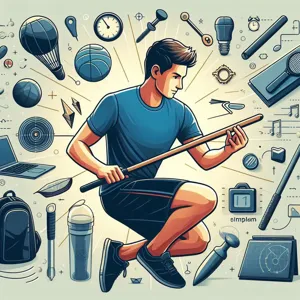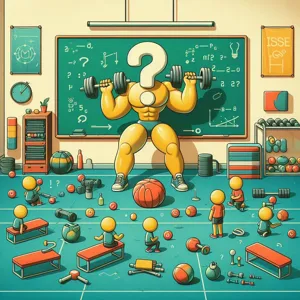Embarking on a new journey in sports or physical activities can be both exhilarating and overwhelming, especially for beginners eager to develop their skills.
Whether you’re stepping onto the court, field, or track for the first time, mastering fundamental techniques is crucial to building a solid foundation for future progress. In this blog post, we’ll explore essential drills that every novice should incorporate into their training regimen to kickstart their skills and boost their confidence. From improving coordination and agility to enhancing strength and technique, these drills are designed to be fun, engaging, and effective—setting you on the path to becoming the athlete you aspire to be. So lace up your sneakers, grab your gear, and get ready to elevate your game with these must-try drills that will not only sharpen your abilities but also ignite your passion for the sport!
1. Introduction: The Importance of Skill Development

In the journey of mastering any skill, the foundational stages are often the most critical. Whether you’re aiming to become a proficient musician, a talented athlete, or a skilled artist, understanding the importance of skill development cannot be overstated. Skill development is not merely a path to proficiency; it is the bedrock upon which confidence and creativity are built.
For beginners, the initial foray into a new discipline can feel overwhelming. With myriad techniques, styles, and methods to absorb, the learning curve can seem steep. This is where essential drills come into play. These drills serve as the scaffolding for your educational journey, breaking down complex skills into manageable components that are easier to practice and master. They help in reinforcing muscle memory, enhancing coordination, and fostering an intuitive understanding of the craft, allowing you to progress steadily and confidently.
Moreover, skill development is a continuous cycle of practice, reflection, and improvement. As you focus on mastering the basics through dedicated drills, you create a solid foundation that not only propels your immediate progress but also sets the stage for more advanced techniques in the future. In an age where instant gratification is often sought, embracing the process of skill development teaches patience, discipline, and resilience—qualities that are invaluable both in practice and in life.
In this blog post, we will explore essential drills that every beginner should master. These drills are designed to not only enhance your technical abilities but also to instill a sense of enjoyment and passion for your chosen skill. Whether you are just starting out or looking to refresh your fundamentals, understanding and committing to these essential drills will set you on the path to success. So, let’s dive in and kickstart your skills!
2. Understanding the Basics: What Are Drills?
In the world of skill development, particularly in sports and various crafts, drills serve as the foundational building blocks that enable beginners to solidify their understanding and proficiency. But what exactly are drills? At their core, drills are structured exercises designed to enhance specific skills through repetitive practice. They are intentional, focused activities aimed at isolating particular movements or techniques, allowing learners to refine their abilities in a controlled environment.
Think of drills as the stepping stones on your journey to mastery. Whether you’re learning to dribble a basketball, swing a golf club, or play a musical instrument, drills break down complex skills into manageable components. For instance, a basketball dribbling drill might involve bouncing the ball in various patterns while maintaining control and speed, helping to develop both coordination and muscle memory. Similarly, a musician might practice scales repeatedly to improve finger dexterity and familiarize themselves with different notes.
The beauty of drills lies in their versatility. They can be tailored to suit various skill levels, from absolute beginners who are just starting to grasp the fundamentals, to more advanced practitioners looking to perfect their techniques. Furthermore, drills can be adapted to the specific demands of different sports or disciplines, ensuring that each learner can find a practice routine that resonates with their personal goals.
Incorporating drills into your training regimen not only enhances your technical abilities but also builds confidence. As you progress through the basic drills, you’ll begin to see tangible improvements, motivating you to push further and explore more advanced techniques. Ultimately, understanding and mastering the basics through drills sets the stage for a successful and fulfilling journey in any skill you choose to pursue.
3. Setting Goals: Defining Your Skill Level

Setting goals is a crucial first step in your journey to mastering any new skill. For beginners, defining your skill level is not just about assessing where you currently stand; it’s about creating a clear roadmap that guides your practice and keeps your motivation high.
start by taking an honest inventory of your current abilities. Are you a complete novice, or do you have some foundational knowledge? By understanding your baseline, you can set realistic and achievable goals that will help you measure progress over time. For example, if you’re learning to play the guitar, a beginner might set a goal to learn three simple chords in the first week, while an intermediate player might aim to learn a full song.
Once you’ve established your starting point, think about where you want to be in the short and long term. Short-term goals could include mastering specific techniques or completing a certain number of practice sessions each week, while long-term goals might involve performing in front of an audience or completing a challenging project.
Remember to use the SMART criteria—Specific, Measurable, Achievable, Relevant, and Time-bound—when setting your goals. Instead of saying, “I want to get better at painting,” you could say, “I will complete one painting every two weeks for the next three months.” This clarity not only helps you stay focused but also allows you to celebrate small victories along the way, which is essential for maintaining enthusiasm and commitment.
By setting clear, defined goals that reflect your skill level, you create a structured approach to learning. This structure not only enhances your practice sessions but also builds a solid foundation upon which you can grow and improve. Embrace the journey, adjust your goals as you progress, and watch as your skills flourish!
4. Drill 1: Fundamental Techniques and Their Importance
When embarking on a journey to enhance your skills, mastering fundamental techniques is akin to laying a solid foundation for a sturdy building. These foundational drills not only hone your natural abilities but also instill confidence and precision in your practice. Whether you’re learning to play a musical instrument, engage in a new sport, or delve into any craft, understanding and executing these fundamental techniques is crucial to your long-term success.
Fundamental techniques encompass the basic movements and actions specific to your skill set. For instance, in sports, this might include proper footwork, grip, or stance; in music, it could involve scales or basic chord progressions; and in visual arts, it might mean mastering brush strokes or color mixing. The significance of these techniques cannot be overstated—they serve as the building blocks upon which all advanced skills are developed.
By dedicating time to practice these essential drills, you will notice a remarkable improvement in your overall performance. Repetition is key; as you refine each movement, muscle memory begins to develop, allowing you to execute tasks with greater ease and fluidity. Furthermore, a strong grasp of fundamental techniques provides the flexibility to adapt and innovate as you progress, enabling you to tackle more complex challenges with confidence.
Consider incorporating a structured routine into your practice sessions that emphasizes these fundamental drills. Set specific goals for each session, focusing on one or two techniques at a time to allow for deep concentration and effective learning. As you continue to master these basics, you’ll build a repertoire of skills that not only enhances your capabilities but also deepens your enjoyment of the craft. Remember, every expert was once a beginner who recognized the importance of mastering the fundamentals. So, roll up your sleeves, and get ready to kickstart your skills with these essential drills!
5. Drill 2: Speed and Agility Exercises

Speed and agility exercises are crucial for beginners looking to elevate their skills in any sport or physical activity. These drills not only enhance your ability to move quickly but also improve your coordination and reaction times, making you more effective on the field, court, or track. Here are some essential speed and agility drills every beginner should master:
1. **Lateral Shuffles**: Start in an athletic stance with your feet shoulder-width apart. Quickly shuffle side to side, making sure to stay low and keep your knees bent. This exercise builds lateral movement skills that are vital in sports like basketball, soccer, and tennis.
2. **Cone Drills**: Set up a series of cones in a straight line or a zigzag pattern. Sprint to the first cone, touch the ground, and then sprint back to the starting point. Repeat this process for each cone, focusing on quick direction changes. This drill mimics real-game scenarios where you have to pivot and accelerate rapidly.
3. **High Knees**: Stand tall and begin jogging in place while lifting your knees as high as possible. Aim for a quick tempo and pump your arms to increase intensity. High knees not only build speed but also engage your core and improve your overall balance.
4. **Bounding**: This drill involves taking large, exaggerated strides while running. Focus on jumping forward with each step, propelling yourself with power from your legs. Bounding helps develop explosive strength and increases your stride length, which is beneficial for sprinting.
5. **Agility Ladder Drills**: Using an agility ladder, perform various footwork patterns such as in-and-outs, side shuffles, and crossover steps. The ladder forces you to focus on foot placement and helps improve your foot speed and coordination.
Incorporating these speed and agility drills into your training regimen will not only enhance your physical abilities but also build a strong foundation for advanced techniques down the line. Remember, consistency is key; practice regularly and focus on maintaining proper form to maximize your progress. As you develop your speed and agility, you’ll notice improvements in your overall athletic performance, setting you on the path to success in your chosen sport.
6. Drill 3: Coordination and Balance Drills
When it comes to mastering any skill—be it in sports, music, or even dance—coordination and balance are crucial foundations that every beginner should focus on. These two elements not only enhance performance but also help prevent injuries, making them essential drills in your learning journey.
**Coordination Drills**: Start with simple exercises that link movements together. One effective drill is the “Ball Toss.” Find a partner or a wall and toss a small ball back and forth while taking steps back to increase the distance. This exercise not only sharpens your hand-eye coordination but also challenges your ability to move while maintaining focus. As you become more comfortable, try adding a twist by catching the ball with one hand or incorporating footwork patterns.
Another excellent coordination drill is the “Ladder Drill.” Use a speed ladder, or simply draw one on the ground with chalk. Perform various footwork patterns—such as high knees, lateral shuffles, and in-and-out steps—while keeping your core engaged. This will not only improve your coordination but also enhance your agility, making your movements more fluid and controlled.
**Balance Drills**: To improve your balance, start with the classic “Single-Leg Stand.” Simply lift one leg off the ground and hold the position for as long as you can. To increase the difficulty, try closing your eyes or standing on a cushioned surface. This will challenge your stabilizing muscles and improve your overall balance.
Progressing to more dynamic exercises, consider the “Balance Beam Walk.” If you don’t have a balance beam, a straight line on the floor works just as well. Walk heel-to-toe along the line, focusing on maintaining your balance. As you gain confidence, add in arm movements or head turns to simulate real-life scenarios where balance is tested.
Incorporating these coordination and balance drills into your routine not only sets a solid foundation for future skills but also builds the confidence you need to tackle more complex movements. With consistent practice, you’ll find that your body responds better to challenges, making your journey toward mastering new skills both enjoyable and rewarding.
7. Drill 4: Repetition Drills for Muscle Memory

Repetition drills are the cornerstone of skill development, particularly for beginners eager to master their craft. These drills focus on the principle of muscle memory, where your body learns to execute movements automatically through consistent practice. Imagine a pianist playing scales over and over again, or a basketball player shooting free throws until their form becomes instinctive. This is the essence of repetition drills.
To get started, select a specific skill or movement that you want to improve. Whether it’s dribbling a soccer ball, executing a perfect serve in tennis, or honing your swing in golf, the key is to break down the movement into manageable parts. For instance, if you’re working on your golf swing, isolate the grip and stance before gradually incorporating the full motion.
Set aside dedicated time each day for these drills. Consistency is crucial; aim to practice for at least 15-30 minutes daily. As you repeat the movements, focus on maintaining proper technique to avoid developing bad habits. It can be helpful to record yourself or practice in front of a mirror to ensure your form is correct.
Additionally, vary the drills slightly to keep your practice sessions engaging. Instead of just repeating the same movement, introduce variations that challenge your coordination and adaptability. For instance, if you’re working on dribbling, try dribbling while moving in different directions or at different speeds.
As you commit to these repetition drills, you’ll start to notice significant improvements. Your body will begin to respond more fluidly, and what once felt awkward will start to feel natural. This fundamental skill-building phase is essential, as it lays the groundwork for more advanced techniques down the road. Remember, mastery comes with time and dedication, so embrace the process and enjoy the journey of becoming proficient in your chosen skill!
8. Drill 5: Game Situations Practice
### 8. Drill 5: Game Situations Practice
As a beginner, it’s easy to get caught up in perfecting individual skills, but truly understanding how to apply those skills in a game situation is crucial for your development. Game Situations Practice is designed to simulate real match conditions, allowing you to think critically and react instinctively to various scenarios. This drill not only enhances your technical abilities but also sharpens your strategic thinking, making it an essential component of your training regimen.
To set up this drill, gather a group of teammates and divide them into two teams. Start with a small-sided game, such as 3v3 or 5v5, played on a smaller field to encourage more interactions and quicker decision-making. This setup forces players to engage more frequently and experience a variety of game-like situations, such as transitioning from offense to defense, making quick passes under pressure, and positioning themselves strategically on the field.
Consider incorporating specific challenges or objectives during the practice. For instance, you could set a goal that each team must complete a certain number of consecutive passes before attempting to score. This encourages players to focus on teamwork and communication, essential elements in any game. Additionally, you might introduce specific scenarios, such as defending a lead or making a comeback, to help players practice strategy under pressure.
After the drill, take the time to review performance. Discuss what worked, what didn’t, and how players can adapt their skills for future games. This reflection not only reinforces learning but also builds confidence as players begin to see their progress in real-time situations. By regularly practicing game situations, beginners will begin to develop a deeper understanding of the game, enhancing their ability to make smart decisions and react effectively when it counts the most. Remember, mastering the game isn’t just about individual talent; it’s about learning to operate effectively within a team dynamic.
9. Incorporating Feedback: Learning from Mistakes
In the journey of mastering any skill, one of the most crucial elements for beginners is the ability to incorporate feedback and learn from mistakes. Unlike a passive experience, skill development thrives on an active engagement with both successes and setbacks. Embracing feedback opens the door to continuous improvement and growth, transforming errors into valuable learning opportunities.
When you make a mistake—be it in technique, timing, or execution—take a moment to reflect on what went wrong. Was it a misjudgment in your approach? Did you overlook a fundamental principle? By honestly evaluating your performance, you can pinpoint specific areas for improvement. This critical self-assessment can be further enhanced by seeking input from more experienced practitioners, coaches, or peers. Their insights can provide fresh perspectives and constructive criticism that you might miss on your own.
Creating a feedback loop is essential. After each practice session, take notes on what you felt was effective and what needs adjustment. If you’re part of a class or training group, consider discussing your experiences with fellow beginners; you might find that they share similar challenges. This collaborative environment fosters a sense of community and encourages everyone to grow together.
Moreover, remember that mistakes are not failures; they are stepping stones on your path to mastery. By cultivating a mindset that views setbacks as opportunities for growth, you set yourself up for long-term success. Celebrate your progress, no matter how small, and remain open to adapting your approach based on what you learn. As you incorporate feedback and learn from your mistakes, you’ll find yourself not only enhancing your skills but also building resilience and confidence—key attributes that will serve you well in your ongoing journey of skill development.
10. The Role of Consistency in Skill Mastery
Consistency is the bedrock of skill mastery, acting as the glue that binds together all your practice efforts into tangible progress. It’s not enough to merely show up and put in the hours sporadically; true enhancement comes from a dedicated, regular commitment to your drills. For beginners, this means establishing a routine that promotes steady improvement over time.
Imagine a musician who practices scales for just a few days every month versus one who dedicates a brief time each day to hone their craft. The latter will undoubtedly see faster growth, as their muscle memory and understanding develop through daily engagement. This principle applies across all disciplines, whether you’re learning to play a sport, mastering a new language, or developing any artistic skill.
To cultivate consistency, start by setting realistic goals that fit into your lifestyle. Break your practice sessions into manageable chunks, focusing on specific drills that target the skills you wish to improve. Even just 20 minutes a day can yield remarkable results when paired with unwavering commitment.
Keep a practice journal to track your progress and reflect on what works and what doesn’t. Celebrate small victories to stay motivated and accountable. Over time, this consistency not only accelerates your learning but also builds a deep-seated confidence in your abilities. Remember, it’s not about perfection but rather the persistence to show up day after day. With each session, you’re not just practicing a drill; you’re forging the foundation of your future expertise.
11. Creating a Balanced Training Schedule
Creating a balanced training schedule is crucial for any beginner looking to make significant strides in their skill development. Just like a well-rounded meal provides all the necessary nutrients for your body, a thoughtfully crafted training schedule ensures that you’re not only honing your primary skills but also developing complementary ones that enhance overall performance.
Start by identifying the key skills you want to focus on, whether it’s improving your dribbling technique in basketball, perfecting your strokes in swimming, or mastering the fundamentals of guitar playing. Allocate specific days for these core skills, ensuring you dedicate ample time to practice each one. However, it’s equally important to incorporate variety. This keeps your training fresh and engaging while reducing the risk of burnout.
Intersperse skill-focused sessions with drills that build strength, agility, and endurance. For instance, if you’re learning to play a sport, include agility drills or strength training in your weekly routine. If you’re picking up a musical instrument, consider adding ear training or music theory sessions to your agenda.
Also, don’t underestimate the power of rest and recovery. Schedule days off or lighter training days to allow your body and brain to recuperate. This not only aids in physical recovery but also helps prevent injuries and promotes mental resilience.
Ultimately, a balanced training schedule is about harmonizing practice, strength, conditioning, and rest. By systematically planning your training, you’ll not only improve faster but also cultivate a lifelong love for your chosen skill. Embrace the journey, and watch as your dedication transforms your abilities!
12. Tracking Progress: How to Measure Improvement
Tracking progress is an integral part of mastering any skill, especially for beginners who are just embarking on their journey. Without a clear understanding of where you started and how far you’ve come, it can be challenging to maintain motivation and focus on your development. Fortunately, measuring improvement doesn’t have to be complex; it can be as straightforward as setting specific goals and documenting your achievements over time.
Start by establishing clear, attainable objectives for each skill you aim to develop. Whether it’s improving your dribbling speed in basketball, enhancing your strumming technique on the guitar, or perfecting your timing in dancing, having defined goals gives you a target to aim for. Break these goals down into smaller, manageable milestones, which not only makes them less intimidating but also allows for more frequent celebrations of success.
Next, create a progress log or journal where you can record your practice sessions. Note down the drills you’ve worked on, the duration of your practice, and any specific improvements you’ve noticed. Over time, this log will serve as a tangible record of your journey and can be incredibly motivating to look back on. Apps and online platforms designed for skill tracking can also be beneficial, offering visual representations of your growth.
Additionally, don’t hesitate to seek feedback from instructors, coaches, or peers. Constructive criticism can provide insights you may not have considered, highlighting areas that need improvement while affirming your strengths. Regularly revisiting and reassessing your goals based on this feedback keeps your training dynamic and responsive to your evolving skills.
Lastly, incorporate self-assessment into your routine. This could be as simple as recording a video of yourself performing a skill and comparing it to previous recordings or to a model performance. This visual evidence can be eye-opening and serve as a powerful reminder of just how far you’ve come.
By actively tracking your progress, setting clear goals, and obtaining feedback, you’ll not only stay motivated but also cultivate a deeper understanding of your learning process. Remember, every small step contributes to your overall improvement, so celebrate your achievements along the way – they are the building blocks of your skill mastery!
13. Staying Motivated: Tips for Beginners
Staying motivated as a beginner can often feel like an uphill battle. The excitement of starting something new can quickly wane when faced with challenges or slow progress. However, maintaining your enthusiasm is crucial for long-term success. Here are some tips to help you stay motivated on your journey.
First and foremost, set realistic and achievable goals. Break down your larger objectives into smaller, manageable milestones. This not only makes your progress feel more tangible but also provides you with a sense of accomplishment as you check each goal off your list. Celebrate these small victories, whether it’s mastering a new skill or simply showing up to practice consistently.
Another effective strategy is to create a supportive environment. Surround yourself with like-minded individuals who share your passion or are also beginners. Join local clubs, online forums, or social media groups dedicated to your skill. Engaging with a community can offer encouragement, accountability, and valuable insights that keep your motivation high.
Incorporating variety into your practice routine can also help combat monotony. Experiment with different drills, techniques, or styles related to your skill. This not only keeps your sessions fresh and exciting but also broadens your understanding and enhances your overall proficiency.
Lastly, remind yourself of the joy that inspired you to start in the first place. Whether it’s the thrill of creating something new or the satisfaction of seeing improvement, keeping that passion at the forefront of your mind can reignite your drive. Consider keeping a journal to reflect on your progress, noting down your challenges, triumphs, and the moments that reignited your passion. This tangible reminder of your journey can serve as a powerful motivator during tougher times.
By implementing these strategies, you can cultivate a mindset that embraces growth and perseverance. Remember, every expert was once a beginner, and the key to mastering any skill lies in your determination to keep pushing forward, even on the days when motivation wanes.
14. Resources for Further Learning and Practice
As you embark on your journey to hone your skills, it’s crucial to have access to the right resources that can facilitate your learning and provide opportunities for practice. Fortunately, the modern age of technology offers a plethora of tools that cater specifically to beginners, ensuring that you can learn at your own pace and master essential drills.
**Online Courses and Tutorials:** Platforms like Udemy, Coursera, and Skillshare offer a wide range of courses tailored for beginners. These courses often include video tutorials, downloadable resources, and interactive quizzes, allowing you to engage with the material in a structured way. Look for courses that focus on your specific skill set, whether it’s playing a musical instrument, coding, or mastering a sport.
**YouTube Channels:** The wealth of knowledge available on YouTube is unparalleled. Search for channels that specialize in your area of interest—many seasoned professionals share invaluable tips, drills, and techniques that can help you grasp the fundamentals. Subscribing to these channels will also keep you updated on new drills and methods.
**Books and eBooks:** Sometimes, a traditional approach is best. Seek out beginner-friendly books that not only cover the theory behind your skill but also provide step-by-step drills to practice. Libraries and online bookstores often have sections dedicated to beginners, so take advantage of these resources.
**Practice Apps:** In today’s digital age, there are countless apps designed to enhance your learning experience. Whether it’s a metronome app for musicians, a coding challenge app for aspiring developers, or a fitness tracker for athletes, these tools can help you practice more effectively and stay motivated.
**Community Forums and Social Media Groups:** Engaging with a community of learners can greatly enhance your experience. Platforms like Reddit, Facebook, and dedicated forums allow you to ask questions, share your progress, and exchange tips with fellow beginners. Learning from others’ experiences and challenges can provide insight and encouragement as you practice.
By leveraging these resources, you’ll not only enhance your learning experience but also ensure that you are consistently practicing the essential drills needed to kickstart your skills. Remember, the key to mastery is not just in practice, but in smart and effective practice—so explore these avenues and find what works best for you!
15. Conclusion: Embracing the Journey of Skill Development
As we reach the conclusion of our exploration into the essential drills every beginner should master, it’s vital to reflect on the overarching theme of this journey: embracing the process of skill development. Every expert was once a beginner, and the path to proficiency is paved with dedication, patience, and a willingness to learn from both successes and setbacks.
Skill development is not just about the drills themselves; it’s about cultivating a mindset that values growth and improvement. Each drill you practice is a stepping stone toward not only mastering a specific skill but also building confidence in your abilities. Celebrate the small victories along the way, whether it’s perfecting a technique, achieving a personal best, or simply gaining a deeper understanding of your craft.
Remember that every moment spent practicing is an investment in yourself. The challenges you encounter will shape your journey and strengthen your resolve. Embrace mistakes as learning opportunities; they are often the most valuable lessons on your path to mastery. Surround yourself with a supportive community, seek feedback, and share your experiences—this camaraderie will enrich your journey and keep you motivated.
Ultimately, skill development is a lifelong journey. Stay curious, remain open to new ideas, and continue to push your limits. As you embrace this journey, you’ll find that the skills you acquire will not only enhance your abilities but also bring joy and fulfillment to your life. So gear up, stay focused, and enjoy the process—your skills are waiting to be unleashed!
As we wrap up our exploration of essential drills for beginners, we hope you feel inspired and equipped to kickstart your skill development. Mastering these foundational exercises is not just about improving your technique; it’s about building confidence and laying the groundwork for future success. Remember, progress takes time and patience, so embrace the journey and celebrate your small victories along the way. Whether you’re honing your craft in sports, music, or any other discipline, consistent practice will lead to remarkable improvement. So grab your gear, dedicate some time to these drills, and watch as your skills flourish. Here’s to your growth and the exciting path ahead—happy practicing!






